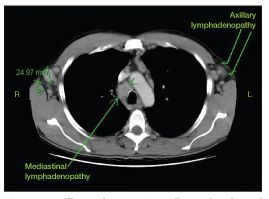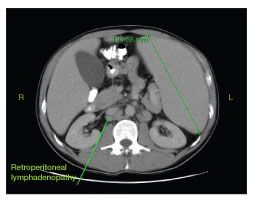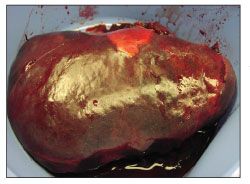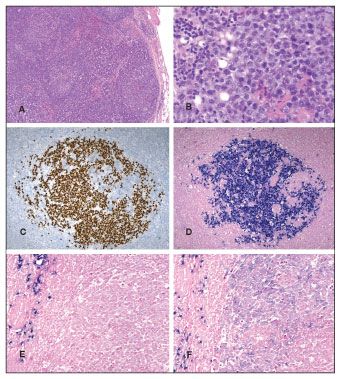- Clinical Technology
- Adult Immunization
- Hepatology
- Pediatric Immunization
- Screening
- Psychiatry
- Allergy
- Women's Health
- Cardiology
- Pediatrics
- Dermatology
- Endocrinology
- Pain Management
- Gastroenterology
- Infectious Disease
- Obesity Medicine
- Rheumatology
- Nephrology
- Neurology
- Pulmonology
Multicentric Castleman Disease, Kaposi Sarcoma, Hemophagocytic Syndrome, and a Novel HHV8-Lymphoproliferative Disorder
Human herpesvirus 8 (HHV8) is associated with Kaposi sarcoma (KS) and 4 lymphoproliferative disorders: multicentric Castleman disease, primary effusion lymphoma, B-cell plasmablastic lymphoma, and germinotrophic lymphoproliferative disorder.
Human herpesvirus 8 (HHV8) is associated with Kaposi sarcoma (KS) and 4 lymphoproliferative disorders: multicentric Castleman disease, primary effusion lymphoma, B-cell plasmablastic lymphoma, and germinotrophic lymphoproliferative disorder.1-4 Presented here is a patient who had multicentric Castleman disease, KS, hemophagocytic syndrome, and a newly described lymphoproliferative disorder.5
CASE SUMMARY
A 45-year-old man presented with tender, generalized lymphadenopathy; fatigue; and fevers (temperature to 40.6°C [105°F]). His history was significant for injection drug use, homosexual contact, and hepatitis C. He was HIV-positive, and HIV-1 polymerase chain reaction (PCR) assay showed an HIV RNA level of more than 100,000 copies/mL. His CD4+ cell count was 64/µL. The patient began antiretroviral therapy with efavirenz, tenofovir, and emtricitabine, and for opportunistic infection prophylaxis, he began a regimen of trimethoprim/sulfamethoxazole. After 2 months, his HIV RNA level dropped to 1894 copies/mL and by 4 months, his CD4+ cell count was 379/µL.
Five months after beginning antiretroviral therapy, his fevers and fatigue returned. On physical examination, the patient had cervical, inguinal, and supraclavicular lymphadenopathy and massive splenomegaly. CT scans of the chest, abdomen, and pelvis revealed diffuse lymphadenopathy and hepatosplenomegaly (Figures 1 and 2). Results of lymph node biopsies to evaluate for lymphoma, infection, and immune reconstitution inflammatory syndrome showed follicular lymphoid hyperplasia with plasma cell differentiation. Given these findings, a diagnosis of immune reconstitution inflammatory syndrome was made, and the patient began taking prednisone 1 mg/kg. However, because of progressive malaise, fevers, weight loss, and dyspnea, the patient was hospitalized.

Figure 1. A CT scan demonstrating axillary and mediastinal lymphadenopathy.

Figure 2. A CT scan showing splenomegaly and retroperitoneal lymphadenopathy.
On admission, he had profound anemia and thrombocytopenia. Laboratory tests yielded the following results: hemoglobin, 7.4 g/dL (normal, 13.5 to 16.0); hematocrit, 21.8% (normal, 37% to 47%); mean corpuscular volume, 83.3 fL (normal, 80 to 98); and platelet count, 81,000/µL (normal, 150,000 to 450,000). The white blood cell count was 5600/µL (normal, 3500 to 11,000), with 74.5% segmented forms (normal, 37% to 75%), 20.4% lymphocytes (normal, 12% to 50%), 4.8% monocytes (normal, 0% to 15%), 0.1% eosinophils (normal, 0% to 7%), and 0.2% basophils (normal, 0% to 2%). The reticulocyte count was 4% (normal, 0.5% to 2.2%), with an absolute count of 68,000/µL (normal, 25,000 to 100,000).
A peripheral smear showed normocytic red cells and little polychromatophilia. There were no spherocytes, schistocytes, or blister cells. A bone marrow biospy specimen showed a hypercellular marrow with trilineage hematopoiesis. There was erythroid hyperplasia, megakaryocytic hyperplasia, and a focal collection of lymphocytes. Plasma cells composed 11% of nucleated cells in the bone marrow aspirate. Iron stores were increased, and sideroblasts were less than 2%. There was no evidence of tumor, lymphoma, granuloma, or fibrosis. Stains were negative for acid-fast organisms. Subsequent cultures of bone marrow showed no growth of bacteria, mycobacteria, or fungi.
Despite blood product support, the cytopenias persisted. Treatment with intravenous methylprednisolone was initiated for symptom control. On review of the case and pathological specimens, the possibility of multicentric Castleman disease was considered.1 Immunohistochemical stain of a lymph node biopsy specimen and PCR assay of peripheral blood were positive for HHV8, which is consistent with the diagnosis of multicentric Castleman disease.6 Further, PCR assay revealed active Epstein-Barr virus (EBV) infection in the lymph node biopsy specimen. Ganciclovir treatment was started at a dosage of 400 mg IV every 12 hours for 1 week.7 The antiretroviral regimen was switched to lopinavir, ritonavir, tenofovir, and emtricitabine to optimize anti-HHV8 activity.8 After 3 weeks of hospitalization without improvement, a single 787-mg dose of rituximab was administered.9,10
Despite these interventions, the patient's health continued to worsen, and he underwent a diagnostic and therapeutic splenectomy.11 Pathological examination revealed a 2-kg spleen with multiple infarcts (Figure 3), numerous foci of atypical immunoblastic proliferation with plasmacytosis, and KS. Histological examination of the retroperitoneal lymph nodes taken during surgery showed multicentric, multifocal, atypical immunoblastic lymphoproliferation, as well as areas of early lymphomatous transformation.

Figure 3.Surgical specimen of patient's spleen. It weighed 2 kg (more than 10 times normal). An area of infarction is visible at the top of the specimen.
Postoperatively, the patient's cytopenias persisted, his renal function declined, and he remained febrile despite treatment with broad-spectrum antibiotic and antifungal agents. Cyclophosphamide was administered in attempt to reduce bulky lymphadenopathy. The patient became hypotensive and died of Gram-negative sepsis after 5 weeks of hospitalization.
Postmortem examination revealed massive cervical, supraclavicular, and axillary adenopathy. Mediastinal, abdominal, and pelvic lymphadenopathy; pleural effusions; ascites; bronchopneumonia; hepatomegaly; and cholestasis were noted. Microscopic examination of the lymph nodes showed large, atypical, HHV8-positive, EBV-positive cells, which formed irregular aggregates. Pleural and peritoneal surfaces were free of lymphomatous involvement. Hemophagocytosis was now found in the bone marrow; compared with a specimen obtained a month earlier, there was a decrease in all hematopoietic elements. PCR testing showed a polyclonal pattern with IgH assays. No clonal B-cell population was identified in any of the tissue obtained. The phenotype of the lymphoproliferative lesions was MUM1+, CD20-/+, CD138-, λ dim+, heavy chain- (Figure 4).5

Figure 4.Cervical lymph node. A, Low power shows a lymph node with several follicles that are partially or completely replaced by a monotonous population of large cells. Features suggesting underlying Castleman disease in this image include loss of normal paracortex, and the presence of sheets of mature plasma cells and some increase in vascularity of the interfollicular area. B, High power of a follicle replaced by large cells with oval, vesicular nuclei, distinct nucleoli, and moderate quantity of pale cytoplasm. C, Nearly all cells in this follicle are HHV8+ (immunoperoxidase technique on a paraffin section). D, The HHV8+ cells show coinfection with EBV (in situ hybridization, Epstein-Barr virus-encoded RNA probe). E and F, Large cells are negative for κ light chain, but some show dim expression of λ light chain (F). Mature plasma cells at the periphery are polytypic and are brightly positive for light chain (in situ hybridization on paraffin sections). (Reproduced with permission from Seliem RM et al. Am J Surg Pathol. 2007.5)
DISCUSSION
KS and 4 lymphoproliferative disorders-multicentric Castleman disease, primary effusion lymphoma, B-cell plasmablastic lymphoma, and germinotrophic lymphoproliferative disorder-are associated with HHV8.1-4 HHV8 is the etiological agent in most cases of HIV-1–positive multicentric Castleman disease, and the clinical findings are related to secretion of a viral analogue of interleukin-6.12,13 Persons who have HIV-1-positive multicentric Castleman disease are at increased risk for concurrent or subsequent KS and lymphoma.1,14
The patient in this case presented a diagnostic puzzle at admission. Immune reconstitution inflammatory syndrome, overt lymphoma, and multicentric Castleman disease were the major diagnostic considerations. Ultimately, he was found to have features of multicentric Castleman disease, KS, hemophagocytic syndrome, and a new type of lymphoproliferative disease.
This case illustrates a fulminant course of what was believed to be multicentric Castleman disease in an HIV-1-infected person; the disease was complicated by KS and a unique HHV8/EBV-associated lymphoproliferative disorder, which has been fully described previously.5 The lymph nodes of our patient displayed atypical follicular hyperplasia with germinal centers containing plasmablasts coinfected with HHV8 and EBV.2 These findings were initially believed to represent either an aggressive case of germinotrophic lymphoproliferative disorder in an immunosuppressed person or an unusual HHV8/EBV-associated plasmablastic lymphoma. This lymphoproliferative disorder was found, after sophisticated pathological analysis, to demonstrate features intermediate between HHV8-positive plasmablastic microlymphoma and HHV8-positive germinotrophic lymphoproliferative disorder. Since light-chain expression was dim and heavy chain was not detected, it is likely to be a new category of HHV8-associated lymphoproliferative disease.5
Our patient also suffered from hepatitis C. Some believe that there is an association between hepatitis C and B-cell non-Hodgkin lymphoma. A 2003 report by Gisbert and colleagues15 of the results of a meta-analysis of 48 studies showed that 15% of patients with B-cell non-Hodgkin lymphoma also has hepatitis C. The prevalence of hepatitis C in the general population is about 1.5%. Hermine and colleagues16 reported that 7 of 9 patients with splenic lymphoma with villous lymphocytes underwent complete remission with loss of detectable hepatitis C virus RNA after treatment with interferon alpha. Two other patients had a partial and complete remission after the addition of ribavirin.16
It is tempting to speculate that our patient's lymphoproliferative disorders were related to his underlying hepatitis C. Early and aggressive treatment of the hepatitis C and intensive chemotherapy for his lymphoproliferative disorder17 might have resulted in a significant response.
Our patient's presentation not only underscores the importance of considering multicentric Castleman disease and its variants in the differential diagnosis for HIV-1-infected persons who present with fevers, lymphadenopathy, and hepatosplenomegaly but also highlights the possibility of multiple and unique HHV8-associated lymphoproliferative disorders occurring simultaneously in persons who have HIV/AIDS.
No potential conflict of interest relevant to this article was reported by the authors.
References:
References1. Dupin N, Diss TL, Kellam P, et al. HHV-8 is associated with a plasmablastic variant of Castleman disease that is linked to HHV-8-positive plasmablastic lymphoma. Blood. 2000;95:1406-1412.
2. Du M, Diss TC, Liu H, et al. KSHV- and EBV-associated germinotropic lymphoproliferative disorder. Blood. 2002;100:3415-3418.
3. Scadden DT, Muse VV, Hasserjian RP. Case records of the Massachusetts General Hospital. Case 30-2006: a 41-year-old man with dypsnea, fever and lymphadenopathy. N Engl J Med. 2006;355:1358-1368.
4. Aboulafia DM, Picozzi VJ, Patterson S. Castleman's disease, Kaposi's sarcoma and immunoblastic lymphoma in a patient with AIDS. AIDS Reader. 1998;8:107-113.
5. Seliem RM, Griffith RC, Harris NL, et al. HHV-8+, EBV+ multicentric plasmablastic microlymphoma in an HIV+ man: the spectrum of HHV-8+ lymphoproliferative disorders expands. Am J Surg Pathol. 2007;31:1439-1445.
6. Soulier J, Grollet L, Oksenhendler E, et al. Kaposi's sarcoma-associated herpesvirus-like DNA sequences in multicentric Castleman's disease. Blood. 1995;86:1276-1280.
7. Casper C, Nichols WG, Huang M, et al. Remission of HHV-8 and HIV-associated multicentric Castleman's disease with ganciclovir treatment. Blood. 2004;103:1632-1634.
8. Leao JC, Kumar N, McLean KA, et al. Effect of human immunodeficiency virus-1 protease inhibitors on the clearance of human herpesvirus 8 from blood of human immunodeficiency virus-1-infected patients. J Med Virol. 2000;62:416-420.
9. Newsom-Davis T, Bower M, Wildfire A, et al. Resolution of AIDS-related Castleman's disease with anti-CD20 monoclonal antibodies is associated with declining IL-6 and TNF-alpha levels. Leuk Lymphoma. 2004;45:1939-1941.
10. Marcelin AG, Aaron L, Mateus C, et al. Rituximab therapy for HIV-associated Castleman disease. Blood. 2003;102:2786-2788.
11. Lerza R, Castello G, Truini M, et al. Splenectomy induced complete remission in a patient with multicentric Castleman's disease and autoimmune hemolytic anemia. Ann Hematol. 1999;78:193-196.
12. Yoshizaki K, Matsuda T, Nishimoto N, et al. Pathogenic significance of interleukin-6 (IL-6/BSF-2) in Castleman's disease. Blood. 1989;74:1360-1367.
13. Staskus KA, Sun R, Miller G, et al. Cellular tropism and viral interleukin-6 expression distinguish human herpesvirus 8 involvement in Kaposi's sarcoma, primary effusion lymphoma, and multicentric Castleman's disease. J Virol. 1999;73:4181-4187.
14. Waterston A, Bower M. Fifty years of multicentric Castleman's disease. Acta Oncol. 2004;43:698-704.
15. Gisbert JP, GarcÃa-Buey L, Pajares JM, Moreno-Otero R. Prevalence of hepatitis C virus infection in B-cell non-Hodgkin's lymphoma: systematic review and meta-analysis. Gastroenterology. 2003;125:1723-1732.
16. Hermine O, Lefrere F, Bronowicki JP, et al. Regression of splenic lymphoma with villous lymphocytes after treatment of hepatitis C virus infection. N Engl J Med. 2002;347:89-94.
17. Gérard L, Bérezné A, Galicier L, et al. Prospective study of rituximab in chemotherapy-dependent human immunodeficiency virus associated multicentric Castleman's disease: ANRS 117 CastlemaB Trial. J Clin Oncol. 2007;25:3350-3356.
